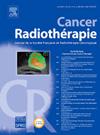Personalizing radiotherapy with adaptive radiotherapy: Interest and challenges
IF 1.5
4区 医学
Q4 ONCOLOGY
引用次数: 0
Abstract
Adaptive radiotherapy (ART) is a recent development in radiotherapy technology and treatment personalization that allows treatment to be tailored to the daily anatomical changes of patients. While it was until recently only performed “offline”, i.e. between two radiotherapy sessions, it is now possible during ART to perform a daily online adaptive process for a given patient. Therefore, ART allows a daily customization to ensure optimal coverage of the treatment target volumes with minimized margins, taking into account only the uncertainties related to the adaptive process itself. This optimization appears particularly relevant in case of daily variations in the positioning of the target volume or of the organs at risk (OAR) associated with a proximity of these volumes and a tenuous therapeutic index. ART aims to minimize severe acute and late toxicity and allows tumor dose escalation. These new achievements have been possible thanks to technological development, the contribution of new multimodal and onboard imaging modalities and the integration of artificial intelligence tools for the contouring, planning and delivery of radiation therapy. Online ART is currently available on two types of radiotherapy machines: MR-linear accelerators and recently CBCT-linear accelerators. We will first describe the benefits, advantages, constraints and limitations of each of these two modalities, as well as the online adaptive process itself. We will then evaluate the clinical situations for which online adaptive radiotherapy is particularly indicated on MR- and CBCT-linear accelerators. Finally, we will detail some challenges and possible solutions in the development of online ART in the coming years.
利用自适应放疗实现个性化放疗:兴趣与挑战。
自适应放射治疗(ART)是放射治疗技术和个性化治疗的最新发展,可根据病人每天的解剖变化进行治疗。虽然直到最近它还只能在 "离线 "状态下进行,即在两次放疗之间进行,但现在在 ART 期间可以对特定患者执行每日在线自适应过程。因此,ART 允许每天进行定制,以确保治疗靶区的最佳覆盖范围和最小边缘,同时只考虑与自适应过程本身相关的不确定性。当目标体积或危险器官(OAR)的位置每天都在变化时,这种优化就显得尤为重要。ART 旨在最大限度地减少严重的急性和晚期毒性,并允许肿瘤剂量升级。这些新成就的取得要归功于技术的发展、新的多模态和机载成像模式的贡献,以及人工智能工具在放射治疗的轮廓、计划和实施方面的集成。在线 ART 目前可用于两种类型的放射治疗机:MR 线性加速器和最近的 CBCT 线性加速器。我们将首先介绍这两种模式各自的优点、优势、制约因素和局限性,以及在线自适应过程本身。然后,我们将评估在线自适应放疗特别适用于磁共振和 CBCT 线性加速器的临床情况。最后,我们将详细介绍在线自适应放疗在未来几年的发展中面临的一些挑战和可能的解决方案。
本文章由计算机程序翻译,如有差异,请以英文原文为准。
求助全文
约1分钟内获得全文
求助全文
来源期刊

Cancer Radiotherapie
医学-核医学
CiteScore
2.20
自引率
23.10%
发文量
129
审稿时长
63 days
期刊介绍:
Cancer/radiothérapie se veut d''abord et avant tout un organe francophone de publication des travaux de recherche en radiothérapie. La revue a pour objectif de diffuser les informations majeures sur les travaux de recherche en cancérologie et tout ce qui touche de près ou de loin au traitement du cancer par les radiations : technologie, radiophysique, radiobiologie et radiothérapie clinique.
 求助内容:
求助内容: 应助结果提醒方式:
应助结果提醒方式:


